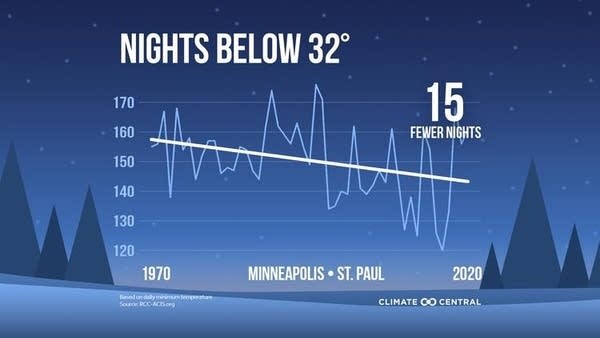First frost coming this week for the Twin Cities?
After a warm start to the week, a big drop in temps is coming

Go Deeper.
Create an account or log in to save stories.
Like this?
Thanks for liking this story! We have added it to a list of your favorite stories.
Highs in the 70s to start October will come to an abrupt end as the coldest air of the season moves in Thursday into Friday, possibly touching off the season’s first frost for Minneapolis and St. Paul.
Frosts are generally coming later due to climate change, which is also creating longer growing seasons and longer allergy seasons.
Cold blast late this week may bring frost
Minneapolis and St. Paul haven’t yet seen a frost this season. That could change Thursday into Friday this week when the coldest air of the season thus far will blast through.

Low temperatures will be very close to the freezing mark in the urban core early Friday and Saturday mornings after a very cool day Friday that will struggle to reach 50 for a high.
Turn Up Your Support
MPR News helps you turn down the noise and build shared understanding. Turn up your support for this public resource and keep trusted journalism accessible to all.
Most of Minnesota and western Wisconsin have already seen their first, at least patchy frost.
Climate change is shifting the averages
The main culprit in the disparity in temperatures between urban and rural is the urban heat island effect, but everyone’s cold thresholds are coming later as nights warm.
Here’s a look at the trend of the first frost in the Twin Cities at Minneapolis-St. Paul International Airport for about the past five decades:

When we look at the Twin Cities National Weather Service office in Chanhassen, almost independent of the urban heat island effects, we see an earlier frost date but the trend is still upward.
Chanhassen only has 25 years of data and see how much it’s changed.

We can take a couple of other examples and look at St. Cloud and Brainerd. Both have earlier frosts than the Twin Cities metro but Brainerd has seen a rather steep warming trend for later frosts.

All of this results in a longer growing season and longer allergy season. The Twin Cities sees about a full month longer growing season on average now compared to more than 50 years ago.

The total number of subfreezing nights has also declined by about two whole weeks worth in a year.

It’s all no surprise when we look at the shifts in warming. In our new 30-year normal (1991-2020), a shift of just a decade (the previous average was 1981-2010) we see our biggest temperature increase in autumn.



